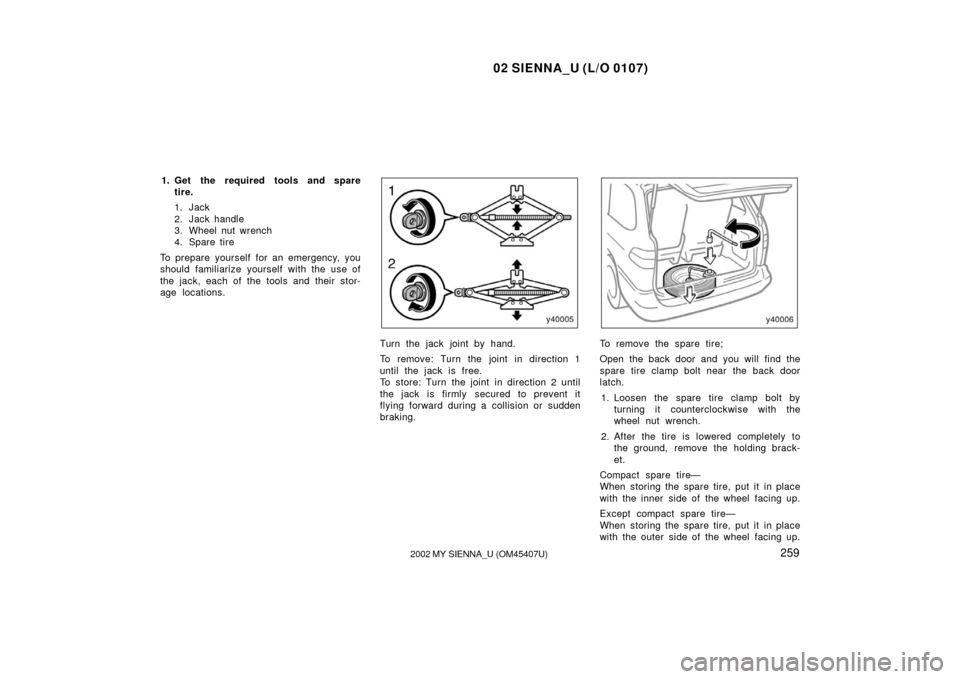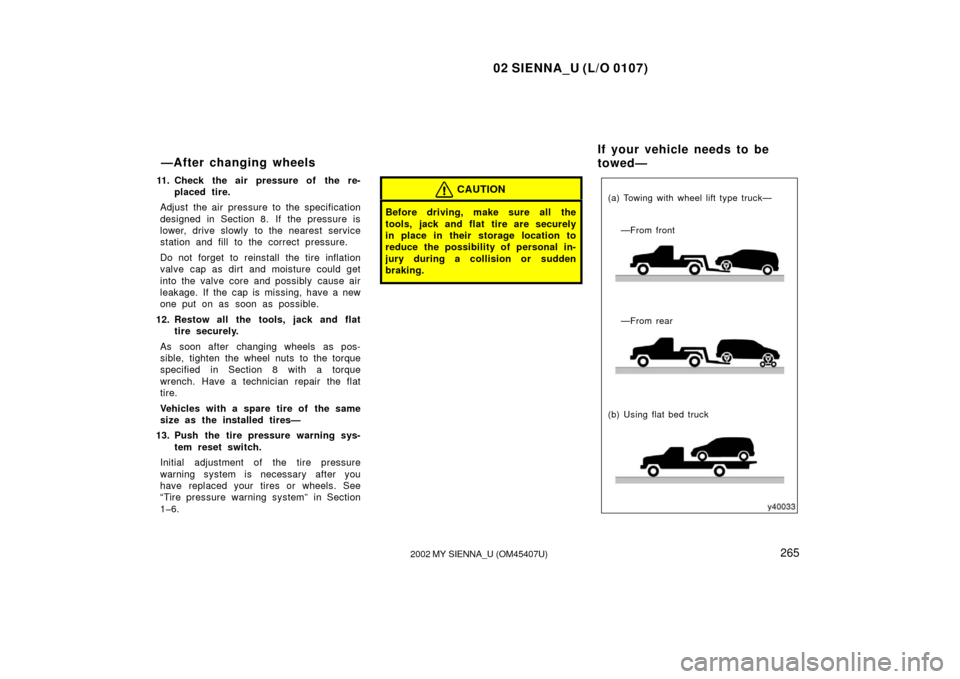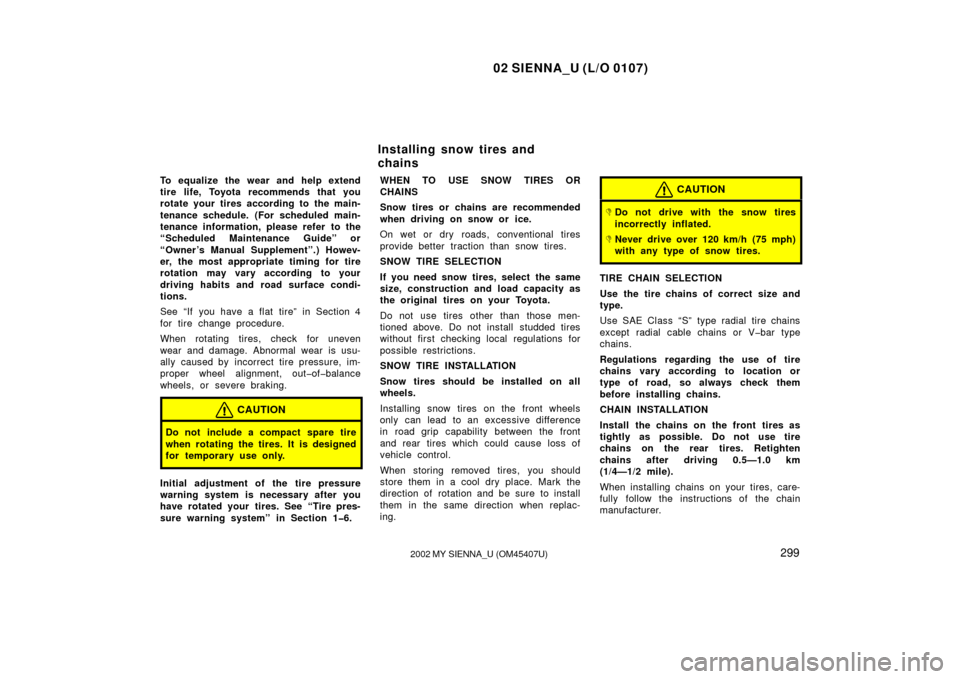Page 263 of 334

02 SIENNA_U (L/O 0107)
2592002 MY SIENNA_U (OM45407U)
1. Get the required tools and spare
tire.
1. Jack
2. Jack handle
3. Wheel nut wrench
4. Spare tire
To prepare yourself for an emergency, you
should fam iliarize yourself with the use of
the jack, each of the tools and their stor-
age locations.
Turn the jack joint by hand.
To remove: Turn the joint in direction 1
until the jack is free.
To store: Turn the joint in direction 2 until
the jack is firmly secured to prevent it
flying forward during a collision or s udden
braking.To remove the spare tire;
Open the back door and you will find the
spare tire clamp bolt near the back door
latch.
1. Loosen the spare tire clamp bolt by turning it counterclockwise with the
wheel nut wrench.
2. After the tire is lowered completely to the ground, remove the holding brack-
et.
Compact spare tire—
When storing the spare tire, put it in place
with the inner side of the wheel facing up.
Except compact spare tire—
When storing the spare tire, put it in place
with the outer side of the wheel facing up.
Page 269 of 334

02 SIENNA_U (L/O 0107)
2652002 MY SIENNA_U (OM45407U)
11. Check the air pressure of the re-
placed tire.
Adjust the air pressure to the specification
designed in Section 8. If the pressure is
lower, drive slowly to the nearest service
station and fill to the correct pressure.
Do not forget to reinstall the tire inflation
valve cap as dirt and moisture could get
into the valve core and possibly cause air
leakage. If the cap is missing, have a new
one put on as soon as possible.
12. Restow all the tools, jack and flat tire securely.
As soon after changing wheels as pos-
sible, tighten the wheel nuts to the torque
specified in Section 8 with a torque
wrench. Have a technician repair the flat
tire.
Vehicles with a spare tire of the same
size as the installed tires—
13. Push the tire pressure warning sys- tem reset switch.
Initial adjustment of the tire pressure
warning system is necessary after you
have replaced your tires or wheels. See
“Tire pressure warning system” in Section
1�6.CAUTION
Before driving, make sure all the
tools, jack and flat tire are securely
in place in their storage location to
reduce the possibility of personal in-
jury during a collision or s udden
braking.
(a) Towing with wheel lift type truck—
—From front
—From rear
(b) Using flat bed truck
—After changing wheels If your vehicle needs to be
towed—
Page 303 of 334

02 SIENNA_U (L/O 0107)
2992002 MY SIENNA_U (OM45407U)
To equalize the wear and help extend
tire life, Toyota recommends that you
rotate your tires according to the main-
tenance schedule. (For scheduled main-
tenance information, please refer to the
“Scheduled Maintenance Guide” or
“Owner ’s Manual Supplement”.) Howev-
er, the most appropriate timing for tire
rotation may vary according to your
driving habits and road surface condi-
tions.
See “If you have a flat tire” in Section 4
for tire change procedure.
When rotating tires, check for uneven
wear and damage. Abnormal wear is usu-
ally caused by incorrect tire pressure, im-
proper wheel alignment, out�of�balance
wheels, or severe braking.
CAUTION
Do not include a compact spare tire
when rotating the tires. It is designed
for temporary use only.
Initial adjustment of the tire pressure
warning system is necessary after you
have rotated your tires. See “Tire pres-
sure warning system” in Section 1�6. WHEN TO USE SNOW TIRES OR
CHAINS
Snow tires or chains are recommended
when driving on snow or ice.
On wet or dry roads, conventional tires
provide better traction than snow tires.
SNOW TIRE SELECTION
If you need snow tires, select the same
size, construction and load capacity as
the original tires on your Toyota.
Do not use tires other than those men-
tioned above. Do not install studded tires
without first checking local regulations for
possible restrictions.
SNOW TIRE INSTALLATION
Snow tires should be installed on all
wheels.
Installing snow tires on the front w
heels
only can lead to an excessive difference
in road grip capability between the front
and rear tires which could cause loss of
vehicle control.
When storing removed tires, you should
store them in a cool dry place. Mark the
direction of rotation and be sure to install
them in the same direction when replac-
ing.
CAUTION
�Do not drive with the snow tires
incorrectly inflated.
�Never drive over 120 km/h (75 mph)
with any type of snow tires.
TIRE CHAIN SELECTION
Use the tire chains of correct size and
type.
Use SAE Class “S” type radial tire chains
except radial cable chains or V�bar type
chains.
Regulations regarding the use of tire
chains vary according to location or
type of road, so always check them
before installing chains.
CHAIN INSTALLATION
Install the chains on the front tires as
tightly as possible. Do not use tire
chains on the rear tires. Retighten
chains after driving 0.5—1.0 km
(1/4—1/2 mile).
When installing chains on your tires, care-
fully follow the instructions of the chain
manufacturer.
Installing snow tires and
chains